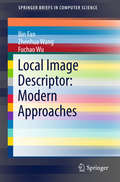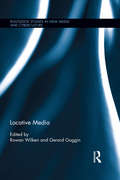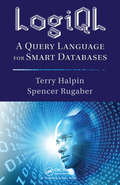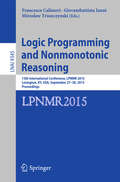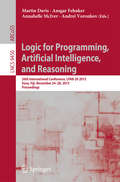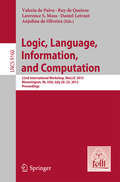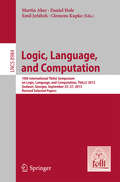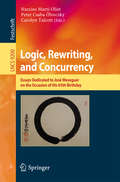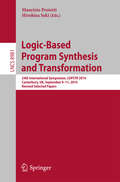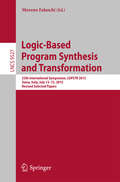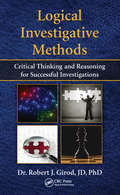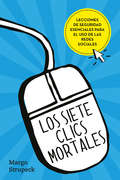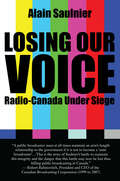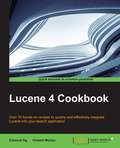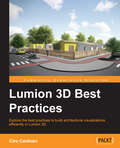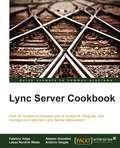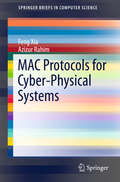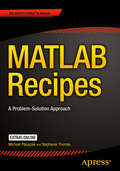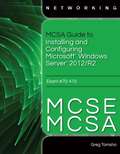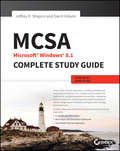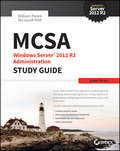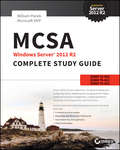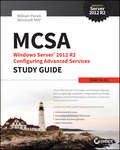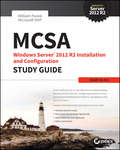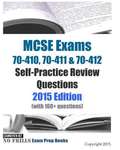- Table View
- List View
Local Image Descriptor: Modern Approaches
by Bin Fan Zhenhua Wang Fuchao WuThis book covers a wide range of local image descriptors, from the classical ones to the state of the art, as well as the burgeoning research topics on this area. The goal of this effort is to let readers know what are the most popular and useful methods in the current, what are the advantages and the disadvantages of these methods, which kind of methods is best suitable for their problems or applications, and what is the future of this area. What is more, hands-on exemplars supplied in this book will be of great interest to Computer Vision engineers and practitioners, as well as those want to begin their research in this area. Overall, this book is suitable for graduates, researchers and engineers in the related areas both as a learning text and as a reference book.
Locative Media (Routledge Studies in New Media and Cyberculture)
by Gerard Goggin Rowan WilkenNot only is locative media one of the fastest growing areas in digital technology, but questions of location and location-awareness are increasingly central to our contemporary engagements with online and mobile media, and indeed media and culture generally. This volume is a comprehensive account of the various location-based technologies, services, applications, and cultures, as media, with an aim to identify, inventory, explore, and critique their cultural, economic, political, social, and policy dimensions internationally. In particular, the collection is organized around the perception that the growth of locative media gives rise to a number of crucial questions concerning the areas of culture, economy, and policy.
LogiQL: A Query Language for Smart Databases (Emerging Directions in Database Systems and Applications)
by Terry Halpin Spencer RugaberLogiQL is a new state-of-the-art programming language based on Datalog. It can be used to build applications that combine transactional, analytical, graph, probabilistic, and mathematical programming. LogiQL makes it possible to build hybrid applications that previously required multiple programming languages and databases. In this first book to co
Logic Programming and Nonmonotonic Reasoning
by Francesco Calimeri Giovambattista Ianni Miroslaw TruszczynskiThis volume contains the refereed proceedings of the 13th International Conference on Logic Programming and Nonmonotonic Reasoning, LPNMR 2015, held in September 2015 in Lexington, KY, USA. The 290long and 11 short papers presented together with 3 invited talks, the paper reporting on the Answer Set Programming competition, and four papers presented by LPNMR student attendees at the doctoral consortium were carefully reviewed and selected from 60 submissions. LPNMR is a forum for exchanging ideas on declarative logic programming, nonmonotonic reasoning, and knowledge representation. The aim of the LPNMR conferences is to facilitate interactions between researchers interested in the design and implementation of logic-based programming languages and database systems, and researchers who work in the areas of knowledge representation and nonmonotonic reasoning.
Logic for Programming, Artificial Intelligence, and Reasoning
by Martin Davis Andrei Voronkov Ansgar Fehnker Annabelle MciverThis book constitutes the proceedings of the 20thInternational Conference on Logic for Programming, Artificial Intelligence, andReasoning, LPAR-20, held in November 2015, in Suva, Fiji. The 43 regular papers presented together with 1 invitedtalk included in this volume were carefully reviewed and selected from 92submissions. The series of International Conferences on Logic for Programming,Artificial Intelligence and Reasoning, LPAR, is a forum where, year after year,some of the most renowned researchers in the areas of logic, automatedreasoning, computational logic, programming languages and their applicationscome to present cutting-edge results, to discuss advances in these fields, andto exchange ideas in a scientifically emerging part of the world.
Logic, Language, Information, and Computation
by Valeria De Paiva Ruy De Queiroz Lawrence S. Moss Daniel Leivant Anjolina G. de OliveiraEdited in collaboration with FoLLI, the Association of Logic, Language and Information this book constitutes the refereed proceedings of the 22nd Workshop on Logic, Language, Information and Computation, WoLLIC 2015, held in the campus of Indiana University, Bloomington, IN, USA in July 2015. The 14 contributed papers, presented together with 8 invited lectures and 4 tutorials, were carefully reviewed and selected from 44 submissions. The focus of the workshop was on interdisciplinary research involving formal logic, computing and programming theory, and natural language and reasoning.
Logic, Language, and Computation
by Martin Aher Daniel Hole Emil Jeřábek Clemens KupkeThis book constitutes the refereed proceedings of the 10th International Tbilisi Symposium on Logic, Language and Computation, TbiLLC 2013, held in Gudauri, Georgia, in September 2013. The conference series is centered around the interaction between logic, language and computation. The contributions represent these three fields and the symposia aim to foster interaction between them. The book consists of 16 papers that were carefully reviewed and selected from 26 submissions. Each paper has passed through a rigorous peer-review process before being accepted for publication. The volume also contains two summaries of the tutorials that took place at the symposium: the one on admissible rules and the one on the formal semantics of aspectual meaning from a cross-linguistic perspective.
Logic, Rewriting, and Concurrency
by Peter Csaba Ölveczky Narciso Martí-Oliet Carolyn TalcottThis Festschrift volume contains 28 refereed papers including personal memories, essays, and regular research papers by close collaborators and friends of José Meseguer to honor him on the occasion of his 65th birthday. These papers were presented at a symposium at the University of Illinois at Urbana-Champaign on September 23-25, 2015. The symposium also featured invited talks by Claude and Hélène Kirchner and by Patrick Lincoln. The foreword of this volume adds a brief overview of some of José's many scientific achievements followed by a bibliography of papers written by José.
Logic-Based Program Synthesis and Transformation
by Maurizio Proietti Hirohisa SekiThis book constitutes the thoroughly refereed post-conference proceedings of the 24th International Symposium on Logic-Based Program Synthesis and Transformation, LOPSTR 2014, held in Canterbury, UK, in September 2014. The 18 revised full papers presented together with 2 invited talks were carefully reviewed and selected from 34 submissions. The aim of the LOPSTR series is to stimulate and promote international research and collaboration on logic-based program development. The papers are organized along a set of thematic tracks: program analysis and transformation, constraint handling rules, termination analysis, security, program testing and verification, program synthesis, program derivation, semantic issues in logic programming and program transformation and optimization.
Logic-Based Program Synthesis and Transformation
by Moreno FalaschiThis book constitutes the thoroughly refereedpost-conference proceedings of the 25th International Symposium on Logic-BasedProgram Synthesis and Transformation, LOPSTR 2015, held in Siena, Italy, inJuly 2015. The 21 revised full papers presented together with 3invited talks were carefully reviewed and selected from 30 submissions. The aimof the LOPSTR series is to stimulate and promote international research andcollaboration on logic-based program development. LOPSTR is open tocontributions in all aspects of logic-based program development, all stages ofthe software life cycle, and issues of both programming-in-the-small andprogramming-in-the-large.
Logical Investigative Methods: Critical Thinking and Reasoning for Successful Investigations
by Robert J. GirodThis book describes how to use logic, reasoning, critical thinking, and the scientific method to conduct and improve criminal and civil investigations. The author discusses how investigators and attorneys can avoid assumptions and false premises and instead make valid deductions, inductions, and inferences. He explains how tools such as interview and interrogation can be used to detect deception and profile unknown individuals and suspects. The book is aimed at improving not only the conduct of investigations, but also the logical use of cognitive, analytical, documentation, and presentation tools to win cases.
Los siete clics mortales
by Margo StrupeckLectura obligada para evitar los problemas más comunes en el uso de redes sociales. En la actualidad, el uso de redes sociales se ha convertido en parte de la vida cotidiana de todos los adolescentes. De esta manera, los límites entre las relaciones del mundo real y las relaciones virtuales son cada vez menos claros. Esta nueva forma de comunicarse requiere de un diálogo constante con padres de familia y profesores, y sobre todo estar alerta ante los riesgos que enfrentan los jóvenes diariamente en internet. Los siete clics mortales es un libro que permite crear conciencia de los peligros que implica la web y presenta de manera simple el mejor uso que puede darse en familia a las redes sociales. English Description Pulling examples from high-profile pop culture cases, Seven Deadly Clicks explains the very real dangers behind common online activities. The book covers everything from over-sharing to sexting, online addiction, and more. Teens and parents will not only learn how to identify and prevent falling into these digital traps, but also how to recover if they do happen to make a mistake. This ebook exclusive acts as an internet safety net, giving teens an entertaining, yet informative, resource to help navigate potential pitfalls and still live fulfilling lives online.
Losing Our Voice: Radio-Canada Under Siege
by Alain Saulnier Pauline CoutureThe inside story of decades of government interference in the work of our national public broadcaster, CBC/Radio-Canada. Is there a quiet campaign to hamstring and silence the CBC? In Losing Our Voice Alain Saulnier, long-time head of news and public affairs at Radio-Canada, documents the decades of political interference that have jeopardized the very existence of one of Canada’s most important cultural institutions. For French-speaking Canadians, with limited options in their own language, the national broadcaster is all the more important. But tensions surrounding national unity and identity have exacerbated the tendency of federal politicians to meddle in CBC/Radio-Canada’s content and management. Saulnier takes us behind the scenes as these tensions play out, and culminate in the punitive Harper budget cuts.
Lucene 4 Cookbook
by Edwood Ng Vineeth MohanThis book is for software developers who are new to Lucene and who want to explore the more advanced topics to build a search engine. Knowledge of Java is necessary to follow the code samples. You will learn core concepts, best practices, and also advanced features, in order to build an effective search application.
Lumion 3D Best Practices
by Ciro CardosoThis book is designed for advanced Lumion users who wish to apply these techniques to their own projects. The reader should be familiar with modeling knowledge and have at least a basic knowledge of a graphics editing program, such as Photoshop or Gimp.
Lync Server Cookbook
by Fabrizio Volpe Alessio GiombiniIf you work with Lync on a daily basis or if you have to use a specific feature of Lync for a project, this is the book for you. For solutions architects, technical consultants, and administrators, if you have a Lync deployment and you want to upgrade, integrate, secure, or extend it to the cloud, you can get valuable information from the recipes in this book.
MAC Protocols for Cyber-Physical Systems
by Feng Xia Azizur RahimThis book provides a literature review of various wireless MAC protocols and techniques for achieving real-time and reliable communications in the context of cyber-physical systems (CPS). The evaluation analysis of IEEE 802. 15. 4 for CPS therein will give insights into configuration and optimization of critical design parameters of MAC protocols. In addition, this book also presents the design and evaluation of an adaptive MAC protocol for medical CPS, which exemplifies how to facilitate real-time and reliable communications in CPS by exploiting IEEE 802. 15. 4 based MAC protocols. This book will be of interest to researchers, practitioners, and students to better understand the QoS requirements of CPS, especially for healthcare applications.
MATLAB Recipes
by Stephanie Thomas Michael PaluszekLearn from state-of-the-art examples in robotics, motors, detection filters, chemical processes, aircraft, and spacecraft. MATLAB Recipes: A Problem-Solution Approach is a practical reference for industry engineers using MATLAB to solve everyday problems. With this book you will review contemporary MATLAB coding including the latest language features and use MATLAB as a software development environment including code organization, GUI development, and algorithm design and testing. This book provides practical guidance for using MATLAB to build a body of code you can turn to time and again for solving technical problems in your line of work. Develop algorithms, test them, visualize the results, and pass the code along to others to create a functional code base for your firm. What you'll learn Learn how to build industrial-strength toolboxes Move beyond a folder of scripts and create well-organized, reusable MATLAB code modules Leverage MATLAB as an IDE and not just a programming language Build a functional code base for your company or department Create your own GUIs for repeatable workflows Who this book is for This book is written for engineers and scientists who use MATLAB on a regular basis and who want to take their coding to a higher level, i. e. people who want to make commercial-quality MATLAB toolboxes. This book may be used by students who are required to use MATLAB for their courses and projects as well as professionals who use MATLAB to solve problems on the job. Table of Contents Part I: Coding in MATLAB 1. Coding Basics 2. MATLAB Style 3. Visualization 4. Interactive Graphics 5. Testing and Debugging Part II: Applications 6. The Double Integrator 7. Robotics 8. Electrical Motor 9. Fault Detection 10. Chemical Processes 11. Aircraft 12. Spacecraft
MCSA Guide to Installing and Configuring Microsoft Windows Server 2012 R2
by Greg TomshoThis book gives you in-depth coverage of the 70-410 certification exam objectives and focuses on the skills you need to install and configure Windows Server 2012/R2.
MCSA Microsoft Windows 8.1 Complete Study Guide
by Jeffrey R. ShapiroComprehensive, hands-on study guide for the Microsoft Windows 8.1 exams The MCSA: Microsoft Windows 8.1 Complete Study Guide is a comprehensive package loaded with educational study tools, including a pre-assessment test, hands-on exercises, hundreds of review questions, exclusive practice exam questions, electronic flashcards, and over an hour of author-led videos. For IT students and professionals, getting certified on Microsoft Windows 8.1 can mean huge career opportunities. Over 90% of all personal computing devices run on Windows, and those certified on the newest version will be in high demand. This comprehensive resource prepares candidates to master all the exam objectives for the Microsoft Certified Solutions Associate (MCSA): Windows 8.1 exams 70-687 and 70-688, as well as the Upgrade exam 70-689. Through real-world scenarios and hands-on exercises, readers are given a solid background in the most essential concepts they need to know for exams. The book guides readers through installing and upgrading to Windows 8.1, configuring hardware and applications, configuring network connectivity and access to resources, monitoring and maintaining Windows clients, and more. This resource's specialized, practical focus is also a benefit to IT help desk and user support professionals who are simply looking to upgrade their skills in Windows. Serves as an comprehensive, practical study guide for those preparing for their MCSA: Windows 8.1 certification Covers all exam objectives and includes invaluable study tools Guides readers through the installation, deployment, upgrading, and maintenance of Windows 8.1 Offers educational benefits for professionals looking to improve their Windows 8.1 knowledge and skills MCSA: Microsoft Windows 8.1 Complete Study Guide promises not only to prepare readers for the MCSA: Windows 8.1 exams, but also for the scenarios and challenges they will encounter professionally once certification has been obtained.
MCSA Windows Server 2012 R2 Administration Study Guide
by William PanekComplete exam coverage, hands-on practice, and interactive studytools for the MCSA: Administering Windows Server 2012 R2 exam70-411 MCSA: Windows Server 2012 R2 Administration Study Guide: Exam70-411 provides comprehensive preparation for exam 70-411:Administering Windows Server 2012 R2. With full coverage of allexam domains, this guide contains everything you need to know to befully prepared on test day. Real-world scenarios illustrate thepractical applications of the lessons, and hands-on exercises allowyou to test yourself against everyday tasks. You get access to aninteractive practice test environment that helps you avoidsurprises on exam day, plus electronic flashcards and videodemonstrations showing how to perform some of the more difficulttasks.Exam 70-411 is one of three exams you must pass to become aMicrosoft Certified Solutions Associate (MCSA) on Windows Server2012 R2 and a clear path to increasing your value and marketabilityin the workplace. The exam reflects the 2012 update to the OS,including the new enhancements to Hyper-V, Storage Spaces, andActive Directory. This guide gives you the information and practiceyou need to master all aspects of Windows Server 2012 R2 for test.Learn how to:Deploy, manage, and maintain serversConfigure file and print servers, network services, andmoreManage and configure Active Directory and Group PolicyReview real-world scenarios, video, and interactive studyaidsIf you're looking to master Windows server administration beforethe exam, MCSA: Windows Server 2012 R2 Administration StudyGuide is a complete and comprehensive prep tool to give you theconfidence you need to succeed.
MCSA Windows Server 2012 R2 Complete Study Guide
by William PanekPrepare for the MCSA Windows Server 2012 R2 Exams Microsoft's new version of the MCSA certification for WindowsServer 2012 R2 requires passing three exams (or one Upgrade exam ifyou have your MCSA or MCITP in Windows Server 2008). Thisvalue-priced study guide includes more than 1,000 pages of qualityexam-prep content, covering 100% of the objective domains of allthree exams (as well as the Upgrade exam, 70-417).In addition, you get access to an interactive practice testenvironment with more than 500 questions, electronic flashcards,and videos showing how to perform the more difficult tasks. Bothfirst-time MCSA candidates and those wishing to upgrade from Server2008 certification will benefit from this complete test-prepguide.Completely updated to cover the Windows Server 2012 R2ExamsProvides a comprehensive study guide for all three MCSA WindowsServer 2012 R2 exams: 70-410, 70-411, and 70-412, as well as theUpgrade exam: 70-417Covers installing and configuring Windows Server 2012;deploying and configuring DNS service; administering ActiveDirectory; creating and managing Group Policy Objects; andconfiguring server roles and features, Hyper-V, and core networkingservicesExplains basic networking concepts, DHCP, deploying andmaintaining servers, configuring a network policy serverinfrastructure and high availability in Windows Server 2012, andmuch moreFeatures real-world scenarios, hands-on exercises, practiceexam questions, electronic flashcards, and over an hour of videodemonstrationsCovers all exam objectivesMCSA Windows Server 2012 R2 Complete Study Guide arms youwith all the information you must master to achieve MCSAcertification on Windows Server 2012 R2.
MCSA Windows Server 2012 R2 Configuring Advanced Services Study Guide
by William PanekThe bestselling MCSA study guide, with expert instruction andhands-on practice MCSA Windows Server 2012 R2 Configuring Advanced ServicesStudy Guide provides focused preparation for exam 70-412 and isfully updated to align with the latest Windows Server 2012 R2objectives. This comprehensive guide covers 100 percent of all examobjective domains, and includes hundreds of practice questions andanswers. You get access to video demonstrations, electronicflashcards, and practice exams, and hands-on exercises based onreal-world scenarios allow you to apply your skills to everydaytasks. Organized by objective, each chapter includes reviewquestions and a list of Exam Essentials that help you judge yourlevel of preparedness every step of the way.Exam 70-412: Configuring Advanced Windows Server 2012 Servicesis the third and final exam in the MCSA certification series, andwas recently updated to cover Server R2. Additions includeenhancements to Hyper-V, Storage Spaces, and Active Directory, soit's crucial that your study guide be up to date as well. This bookcovers the entire exam, including the new information, withexpert instruction and easy-to-follow explanation that helps youto:Configure network services, high availability, informationprotection, and moreImplement business continuity and disaster recoverysolutionsGet hands-on practice in real-world scenariosPass this one last exam and you become a Microsoft CertifiedSolutions Associate - someone with trusted, demonstratedexpertise in the server software with over 83 percent market share.Businesses rely on Windows Server, and the people who understandthem are in demand. Thorough preparation is the key to examsuccess, and MCSA Windows Server 2012 R2 Configuring AdvancedServices Study Guide provides all the information you need toknow.
MCSA Windows Server 2012 R2 Installation and Configuration Study Guide
by William PanekMaster Windows Server installation and configuration withhands-on practice and interactive study aids for the MCSA: WindowsServer 2012 R2 exam 70-410 MCSA: Windows Server 2012 R2 Installation and ConfigurationStudy Guide: Exam 70-410 provides complete preparationfor exam 70-410: Installing and Configuring Windows Server 2012 R2.With comprehensive coverage of all exam topics and plenty ofhands-on practice, this self-paced guide is the ideal resource forthose preparing for the MCSA on Windows Server 2012 R2. Real-worldscenarios demonstrate how the lessons are applied in everydaysettings. Readers also get access to the interactive practicetests, electronic flashcards, and video demonstration of the moredifficult tasks, which help readers fully understand the scope ofprinciples at work.Exam 70-410 is one of three exams MCSA candidates must take toobtain their MCSA: Windows Server 2012 R2. The test is aligned withthe 2012 update to the Windows server operating system, and so isthe book. This study guide contains everything users need to knowfor the exam, including the 2012 update's changes to Hyper-V andActive Directory. Avoid surprises on exam day, and master thematerial while learning to:Install and configure Windows Server 2012 R2Configure Hyper-V and server roles and featuresInstall and administer Active DirectoryManage Group PolicyExam prep is about more than passing the test--it helps yougain hands-on experience performing more complex operations, givingyou the confidence you need to successfully apply what you'velearned in a work environment. If you're looking to triumph overthe MCSA exam 70-410, MCSA: Windows Server 2012 R2 Installationand Configuration Study Guide: Exam 70-410 provides theinformation and practice you need.
MCSE Exams
by The Editors at the ExamREVIEWLearn more about what you'll be asked in the MCSE exams!
